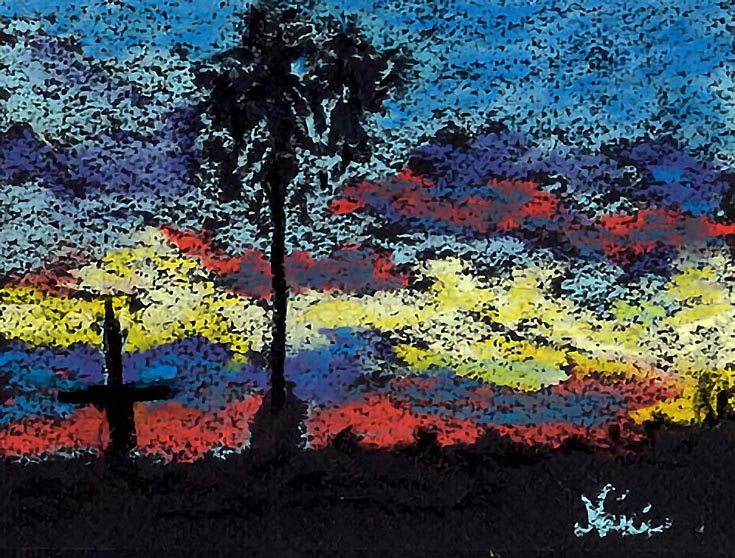One of the joys of opening a new box of soft pastels is seeing the brilliant contrast of colors. And among all those other, brighter hues, you’ll also see that tempting stick of black pastel.
While many pastel artists avoid using black pastel altogether, black pastel can enhance your painting when applied judiciously. So if you’ve been discouraged from using black pastel (but are still curious), or just want to try pastels in general, here are four ways to utilize that unique black stick beckoning from the pastel box:
1. Creating a charcoal effect
Black pastel can be an effective substitute for charcoal, since it yields a similar effect when used in a black and white drawing. Using black pastel is particularly helpful if you like to work on large pieces (it covers the surface very quickly) and depending on the brand, it may be larger and more comfortable to hold than a stick of charcoal.
Keep in mind, however, that black pastel can be difficult to work with if you’re used to erasing charcoal or lifting out highlights later. With pastel, you’ll need to work in soft layers and plan ahead to avoid mistakes.
2. Adding contrast
If you’re incorporating black pastel into a piece with color, it’s best to do it carefully, and preferably toward the final stage of your piece. (Black pastel will quickly take over a painting, and doesn’t do well under other colors.)
After you’ve brought your painting to the stage where your lights, darks, and basic color scheme are blocked in with details, you can see if the piece would benefit from a few touches of black pastel for emphasis. Make sure the areas are small punches of black detail, so that they add to the painting rather than create “holes” in the composition.
Also, be sure your use of black pastel is consistent, so that it appears throughout the piece (for example, if you’re adding it to the eyes in an animal portrait, add a few touches of it to the fur patterns or whiskers to unify the painting).
3. Making colors richer
When searching for deep darks to use in your pastel painting, it’s tempting to reach for black pastel. There are plenty of other ways to create deep shadows without using black—in fact, it’s important that your shadows have color in them to convey the temperature.
That said, there’s no harm in working in a little black to deepen your shadows if you’re painting, for example, a night scene, or using black pastel paper.
The key is to lay in your composition, with basic lights and darks, before adding a bit of black pastel to the darks. Work a little color into the black pastel to show whether the shadows are warm or cool, and you’ve got some nicely contrasting darks to emphasize an especially deep area of shadow.
Black pastel is especially helpful on textured black paper, particularly if you feel that the dust from the lighter colors has spread and lightened the value of the black paper. A few hints of black on the darkest areas of a painting on black paper will help bring the contrast back to your piece, allowing the bright colors and highlights to shine.
4. Placing your signature
Last but not least, save those black pastels for signing your work—as long as there are other areas of deep darks in your painting, the black pastel signature will make a nice complement to the work, standing out just enough for viewers to recognize, but still fitting in with the overall feel of the painting.
Using black pastel can be a matter of taste for many artists—I learned to use it as a student, only to shun it for many years. Now I wish I hadn’t!
Of course, if you like deep darks, but are shy about using black, there’s always the option of using a deep charcoal gray instead. Like any painting technique, it’s best to use your own method to find what works for you—and never be afraid to experiment!
This post may contain affiliate links.


